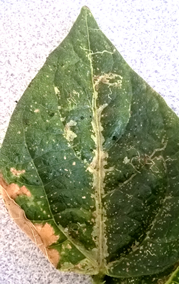
Damage to a green bean leaf. Photo by John Duff.
Another exotic leaf-mining fly, the serpentine leafminer (SLM; Liriomyza huidobrensis), also known as pea leafminer or South American leafminer, has recently been found in commercial vegetable crops (celery and green beans) in the Fassifern Valley (90 km south-west of Brisbane). This follows its previous detection in western Sydney in early November. The national plant pest and disease incursions technical committee has determined it is no longer feasible to eradicate this pest from Australia as it is too widely spread.
Serpentine leafminer has a wide host range and poses a serious economic threat to Australia’s ornamental and horticulture industries, and (to a lesser extent) to many pulse crops.
The larvae feed internally on plant tissue, particularly the leaf, causing highly visible mining damage, often appearing as pale ‘squiggly’ or ‘serpentine’ patterns. Severe infestations may result in premature leaf drop, poor growth and reduced crop yields. The damage symptoms are very similar to those of the vegetable leaf miner (another exotic species, but which to date has been only found in far northern Cape York).
The pest is in the same group of flies (the Agromyzids) as the ordinary bean fly (Ophiomyia phaseoli) and soybean stemfly (Melanagromyzae sojae). Adults are wind borne and eggs, larvae and pupae can be moved in plant material (e.g. nursery plants) and soil. Growers and consultants are urged to keep a look out and report any suspected outbreaks.
Identification
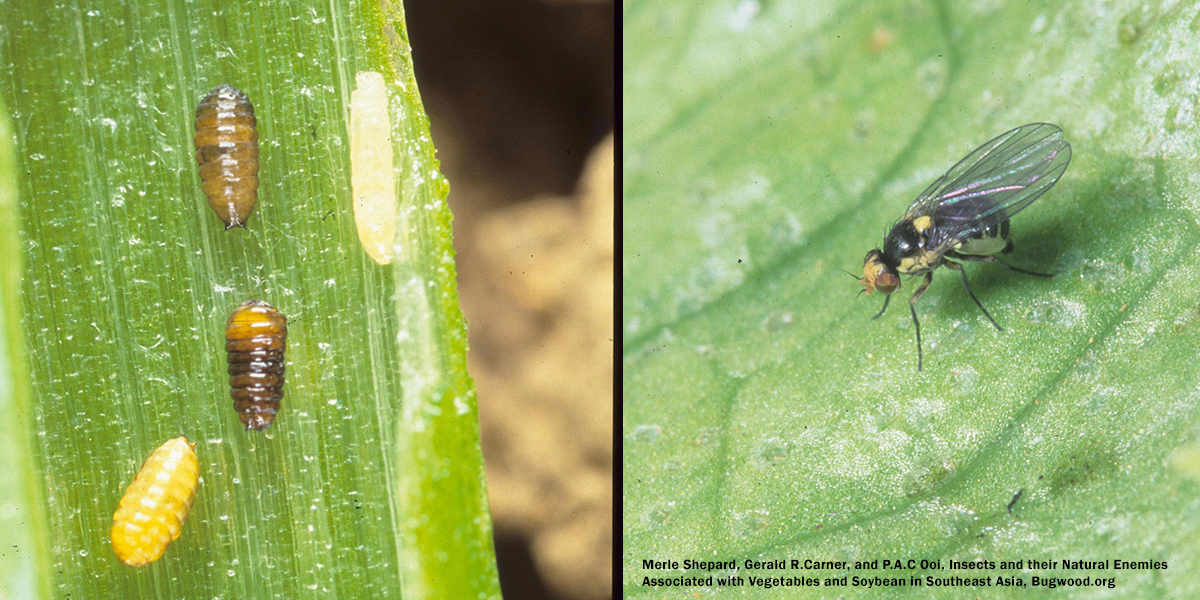
Pupae (3), larva and adult of serpentine leafminer. Note the yellow patch between the wing bases, and the yellow face and underbody of the adult fly (source: bugwood.org).
Serpentine leafminer (SLM) adult flies are about 2 mm long and are easily distinguished from beanfly and soybean stemfly by the yellow patch between the base of their wings, and their yellow face and underbody (bean fly and stem fly adults are mostly black). The closely-related American serpentine leafminer (Liriomyza trifolii) (NOT yet reported in Australia) has a similar colouration to SLM, but the top of the thorax is a matte dark grey, not a shiny black.
The elliptical eggs are pale white, 2 mm long and are laid into the leaf. Oviposition stings look like pinprick holes when infested leaves are held up to the light. Bean fly and soybean stem fly produce similar sting marks on the leaves, but their larvae burrow down the petioles to the plant’s stem.
There are three larval instars. Larvae are initially translucent, progressing to yellow/orange in the final instar, which reaches 3.25 mm long. The larvae are legless maggots with dark hooked mouth parts, but no head capsule. SLM larvae mainly mine leaves, and sometimes pods (bean and stem fly larvae primarily feed in stems), and under magnification, the three species have distinctively different posterior spiracles.
SLM pupae darken to brown and are about 1.5 mm long.
Biology
Serpentine leafminers can lay over 100 eggs per female. Larvae feed within the leaf and when mature usually exit the mines through a pre-cut semicircular slit and drop to the ground to pupate, but sometimes they pupate in the leaf mines. The life cycle takes only two weeks in warm weather, with about two days for eggs, five days for larvae, and seven days for pupation. Serpentine leafminer development is favoured by moderate temperatures and is likely to be adversely affected by periods of extreme heat such as those recently experienced.
Hosts
Serpentine leafminer has a wide host range. Pulse crops attacked overseas include faba beans, chickpea, cowpea, field pea, lima bean, navy bean, soybean, pigeon pea, and lupins. Mungbeans are considered at lesser risk as they are rated as a poor host. Other crops attacked include brassicas, cucurbits and solanaceous crops, beetroot, celery, lettuce, beans, peas, onions, as well as lucerne, many cut flower species, and a large number of weeds.
Damage symptoms
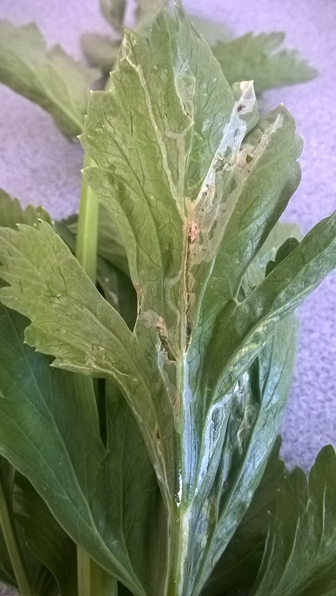
Damage to celery. Photo by John Duff.
The pest is primarily a leaf feeder, but can also damage petioles, and soft succulent pods, as in field peas. Punctures caused by feeding and egg-laying females may cause a stippled appearance on leaves and stems, however this damage is negligible compared to the larval leaf mining activity. SLM larvae feed under the surface of leaves (in leaf mines) and petioles causing long, narrow ‘mines’ which appear as white or grey wiggly lines. Severe damage may kill leaves, and affects the plant’s ability to photosynthesise, thereby reducing plant growth, and reducing crop yields. In some vegetable crops, the cosmetic damage alone has a major impact on crop value. While beanfly and stemfly also lay eggs in leaves, their larvae usually move down the plant through the petioles to the stems, the former feeding in the vascular tissue, and the latter in the stem pith. In crops suffering late beanfly attack (particularly in navy beans), damage may be restricted to the leaves and petioles, but there is not the distinctive leaf mining of SLM.
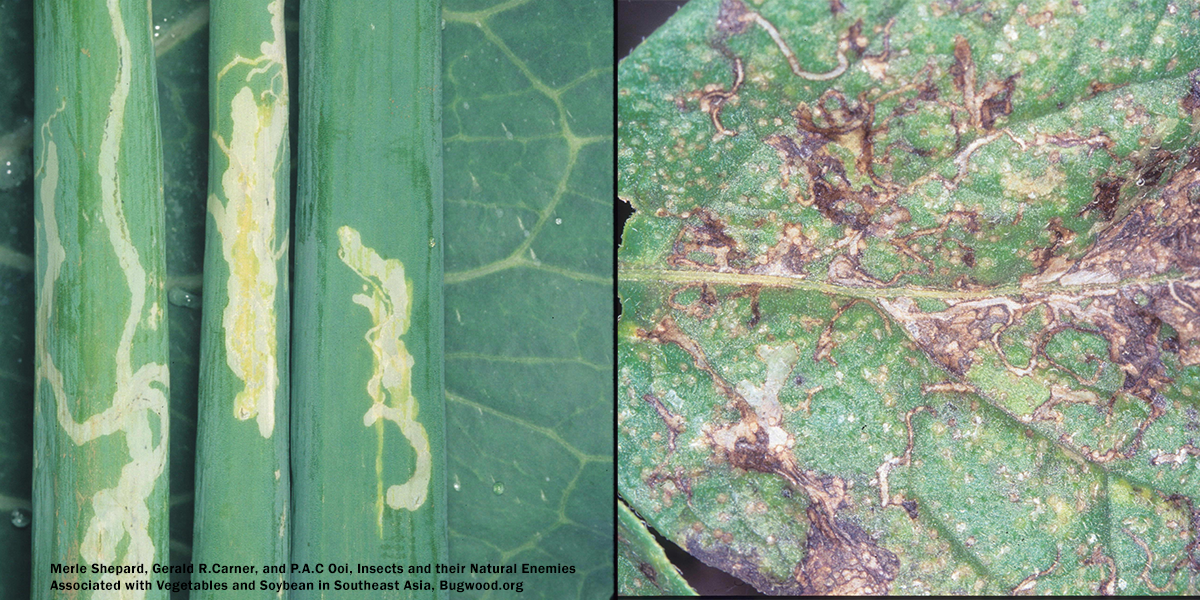
Typical convoluted damage by serpentine leafminer to onion and potato leaves (source: bugwood.org).
Other leafmining pests in pulses
The leaf mines may be confused with those made by other leafminers, especially in soybeans, which hosts soybean moth and soybean leafminer. However, the mines made by these caterpillars are much broader and are not as convoluted or elongated. Also, these two caterpillar pests have legs and well-defined head capsules. Other caterpillars including grass blue butterfly (larvae) and young helicoverpa sometimes inflict leaf windowing damage (where one epidermal layer of the leaf is left intact) that could be mistaken for leaf mines.
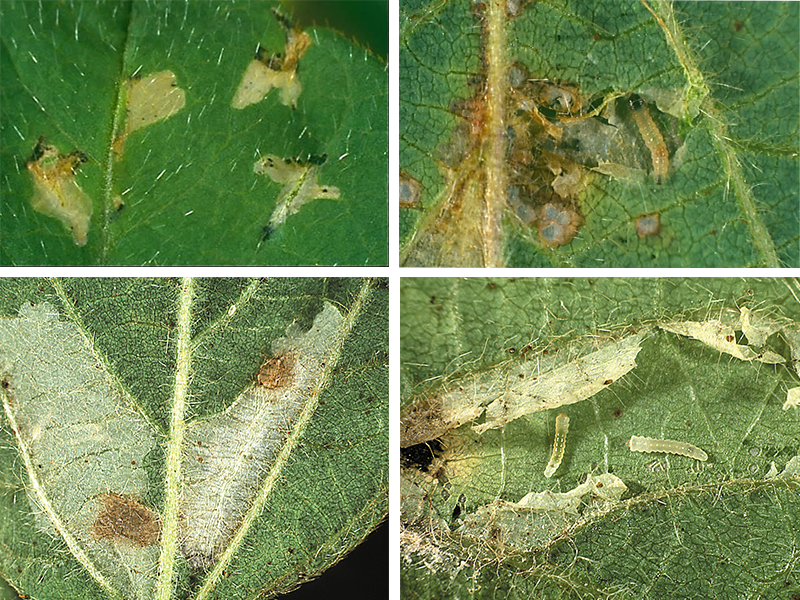
Top: Soybean moth—mines (blisters) made by small larvae (left), and a medium larva (4.5 mm). Bottom: Soybean leafminer damage (left) and large larvae (3 mm). Photos by Joe Wessels.
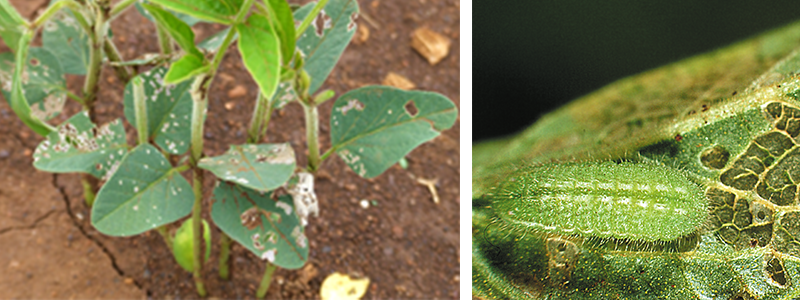
Leaf windows (left) made by grass blue butterfly larvae (10 mm – right). Photos by Hugh Brier and Joe Wessels.
Monitoring
The distinctive leaf mines should give early warning of pest presence. Adult flies can be monitored with sweep nets or sticky traps. Also look for SLM activity in earlier-planted crop hosts and nearby fields.
Thresholds
No thresholds are officially set for SLM and similar leafminers in pulses. Note that in pulse crops grown for grain, thresholds will be much higher than in vegetable crops where leaf appearance is critical.
Provisional thresholds are based on % leaf defoliation as set for other leaf-feeding pests. For these, the rule of thumb is that no yield is lost if defoliation remains below 33% in vegetative crops and 16% in podfilling crops. However, if the cost of control and impacts on beneficial insects are factored in, the tolerable defoliation could be as high as 40% and 20% respectively.
Insecticide options
A minor use permit PER89184 has been secured for the control of leafminer flies in pulses with dimethoate at 800 mL/ha.
Natural control and IPM
Maintain good farm hygiene to remove alternative weed hosts.
There are a number of small native chalcid wasps targeting bean and stem flies that could attack this new pest. Field observations of a recent soybean stem fly outbreak in the Casino region showed increased parasitism as the summer progressed. Overseas experience suggests that a key SLM strategy is to ‘go soft early’, use soft biopesticides (such as NPVs and Bts) against caterpillar pests, and to delay sucking pest sprays until podfill. As well, don’t panic and spray at the first sign of SLM. Please report the damage and watch for any increase in SLM activity, but give the parasitoid populations a chance to build up.
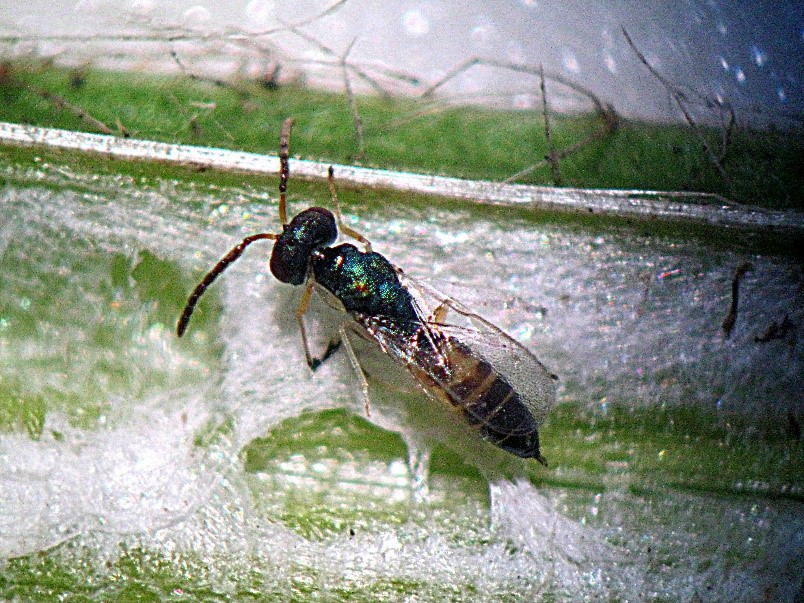
The parasitoid wasp Eupelmidae sp. (2.5 mm) attacks soybean stem fly, and is a potential natural enemy for leafminer. Photo by Joe Wessels.
Please report suspected outbreaks
If you suspect you might have a SLM infestation, report it to the DAF customer service centre. If in pulse crops, please also contact DAF senior entomologist Hugh Brier on 0741 600 740 or 0428 188 069.
More information on serpentine leafminer can be found at:
Horticulture resources:
Please note: interstate restrictions until the 31 January 2021 regarding movement of plants and equipment have been announced by WA. Visit the DPIRD website for more details.
